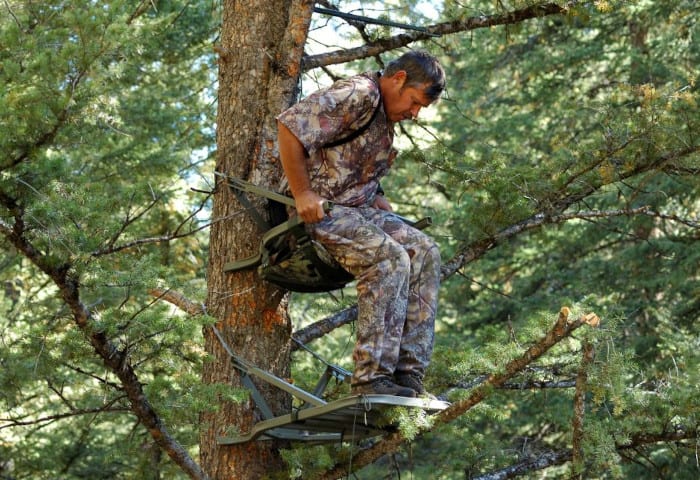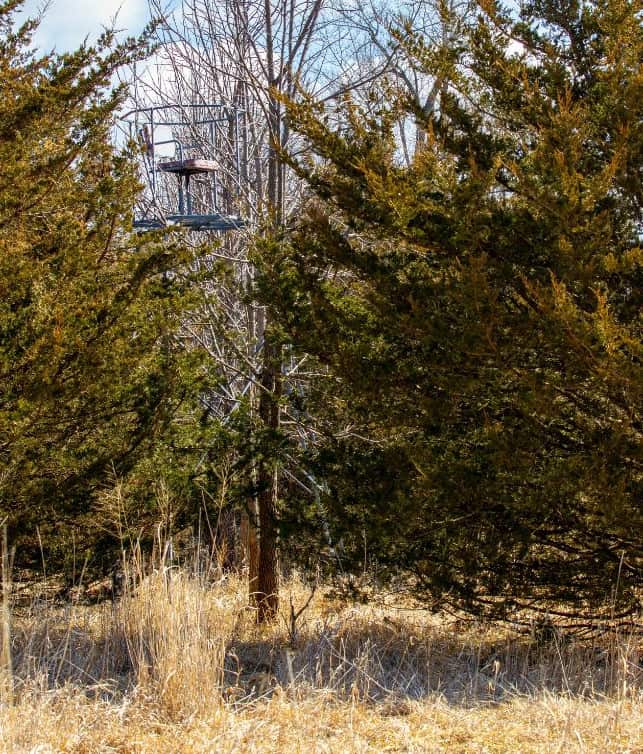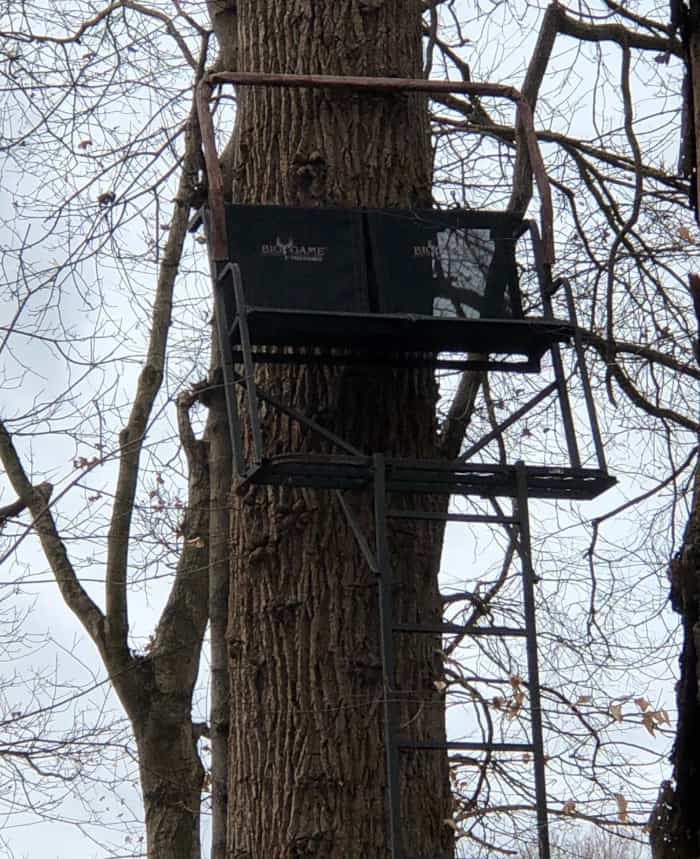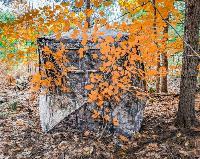I’ve always believed that strategic deer stand placement is the key to a successful hunting season. Stand placement can make or break a successful hunt, so it’s an integral part of any deer hunting strategy. It’s all about finding the perfect spot to set up your stand, taking into consideration factors like wind direction, access, and timing. By carefully choosing the right location, you can increase your chances of spotting and taking down a trophy buck.

In this post, I’ll try to answer the following question: whats the best location for a tree stand, and delve into a couple of tree stand-related topics, including:
- Different strategies for wind direction
- The different types of deer stands
- The best timing and location for setting up your stand
- Specific scenarios that require unique placement.
By following these guidelines, you’ll be well on your way to a successful hunting season.
Key Points
– Wind direction and access are crucial for deer stand placement.
– The specific stand type should be chosen based on the type of tree and the desired level of camouflage.
– Timing and location are important factors to consider when hanging stands.
– Specific deer stand placement scenarios, such as using decoys or setting up near water sources, can increase hunting success.
Tree Stand Strategies for Wind Direction
When it comes to strategic deer stand placement, one adage I always keep in mind is ‘hunt the wind.’ By setting up my stand on the upwind side of the trail, I try to ensure that my scent is carried away from the deer, increasing my chances of a successful hunt.
While there are hundreds of different opinions on scent control, I believe that scent control is crucial when hunting whitetails, as they have a keen sense of smell and can easily detect human odors. I’m not going to go through an entire write-up about scent control in this post because I think it’s a topic worthy of its own post. However, I will briefly skim over some odor control measures I use in relation to hunting stands:
- Before setting up my stand, I spray it with scent elimination spray to minimize any human or foreign scent (like lubrication oil).
- I make sure to thoroughly wash my hunting clothes with scent-free detergent and store them in a scent-free bag.
- Additionally, I use scent elimination sprays on all my gear and only wear my hunting boots in the woods.
Let’s briefly discuss the different tree stand types.

Types of Tree Stands
I’ve tried or tested almost every tree stand style on the market, including hang-on models, climbers, saddles, and ladder stands. All those styles have hunting situations or scenarios where they shine and then other situations when they may not be the best option for a specific scenario.
That being said, I prefer using climbing treestands on straight trees with good cover. I like climbing stands because they potentially offer several advantages over some other stand types.
First, they are very mobile, as they can be easily attached to different trees. This is especially helpful when hunting in areas with limited suitable trees or in situations when it becomes necessary to move your stand to another location. Second, climber stands can offer a higher vantage point, allowing for better visibility and shot angles. This is particularly advantageous when hunting in open areas or areas with thick undergrowth.
Additionally, climbing tree stands are lightweight and portable, making them ideal for hunters who need to move frequently. They also offer a comfortable seating position, which is essential for long hours of hunting. For those reasons, climbing stands are probably my go-to stand choice.
Now, that’s not to say that other stand styles are bad or don’t work. In some situations, a box stand may be a better option than a climbing treestand or a ladder stand.
Scouting and Stand Placement Strategy
How do you determine the perfect tree or location for your stand? Opinions always vary, but, for me, the answer is scouting. I prefer to use a combination of in-person scouting, searching for deer sign, and game camera data to assist me in choosing my stand locations.
In a perfect world, I prefer to hang my stands or choose a stand location at least 4-6 weeks before the deer season to allow the deer to get accustomed to their presence. However, that option isn’t always ideal, especially in situations where it becomes necessary to relocate a stand.
During the early season, I find the best locations for tree stands are between food sources and bedding areas, as this is where deer are most likely to travel. If I can’t locate a good stand position between feeding and bedding areas, I try to position stands near food sources or food plots. Oak trees, especially when acorns drop, are popular whitetail food sources. I also like to hang a stand within shooting distance of heavily traveled trails.
During the rut, I change tactics a bit and focus on tree stand placement in locations where does are most likely going to be present. If you can find does during the rut, the mature bucks won’t be far behind.
As part of the scouting process, I also like to incorporate topographic maps and Google maps to help identify terrain funnels, such as pinch points, fence lines, and game trails that naturally guide deer movement.
Trail Cameras Can Help in the Scouting Process
I’m a big fan of trail cameras as they are an indispensable tool in my scouting process. Those cameras allowed me to monitor deer activity and help make decisions about the following:
- The best time to hunt
- Tree stand positions
- Food sources
- Bedding locations
- Travel patterns
I placed cameras in high traffic areas, such as heavily used trails or near food sources, to gather valuable information about deer behavior. This enables me to make educated decisions about when and where to set up my stand for optimal success.

Frequently Asked Questions
Here are some commonly questions associated with deer stand placements and tree stands in general:
What are the best camouflage options for tree stands?
Most any camouflage pattern will work in a tree stand. Ideally, the camo pattern will either match the tree bark and leaves or help break up your silhouette.
How do you determine the ideal height for a tree stand?
When determining the ideal height for a tree stand, consider the shot angle and advantages of being between 15 and 25 feet high. I prefer to mount a tree stand higher rather than lower because I like the higher vantage point. It’s also worth noting that some states have minimum tree stand height requirements, so deer hunters need to be familiar with those regulations.
Are ladder stands suitable for all types of trees?
Ladder stands are versatile and can be hung on most trees, but their stability may vary depending on the tree’s characteristics. It’s important to ensure the ladder tree stand is securely attached to the tree for safety and stability. I prefer to set up ladder models on trees with a straight trunk and then cover the stand with a green or brown canvas for additional concealment.
What are some tips for setting up tree stands in heavily used trails?
To avoid detection on heavily used trails, choose a treestand location that provides cover and minimizes your visibility. Set up on the downwind side of the trail to mask your scent. Additionally, consider the weather conditions and adjust your stand placement accordingly. I would also be careful about hanging a stand too close to the trail. I generally try to position a stand at least 25 to 30 yards away from a game trail.
How can trail cameras be used to improve deer stand placement?
As I mentioned previously, using trail cameras to monitor deer movement is crucial for improving deer stand placement. It allows me to identify high-traffic areas and determine the best locations for setting up stands.
What is a deer stand?
A deer stand, also known as a tree stand, is a platform hunters use to elevate themselves above the ground to better spot and shoot deer. It provides an elevated vantage point and helps hunters stay hidden from deer.
What is the best tree to hang a tree stand?
For me, the best tree to hang a tree stand is one that provides good cover and concealment, has sturdy branches for support, and is located in an area frequented by deer. Look for a tree with a straight trunk, plenty of branches for cover, and is within shooting range of deer trails or feeding areas.
What are some tips for deer stand placement?
Some tips for deer stand placement include choosing a location near bedding areas or food sources, hanging the tree stand at least 15-20 feet high, and placing it in a spot where you have a clear shooting lane. It is also important to consider wind direction and access to the stand without spooking deer.
Where are the three best places to hang your tree stand?
The three best places to hang your tree stand are near food plots, along deer trails, and near bedding areas. These locations provide good opportunities for spotting and shooting deer.
How do I access my stand without spooking deer?
Getting to your tree stand location as quietly as possible can be difficult but can also play a role in your whitetail hunting success. I try to plan my route heading into a treestand, and prefer to use existing deer trails, logging paths, or some kind of game trail to make a quiet entry to your stand. I suggest trying to be as quiet as possible, wearing scent-blocking clothing, and, if possible, choosing a location that allows you to approach your stand from downwind of where you expect the deer to be.
What should I consider when hanging a tree stand?
When hanging a tree stand, the factors I look at include tree stability, visibility from the stand, shooting lanes, and wind direction. Choose a tree that allows you to break up your outline and provides a good view of the area. Also, make sure to hang the stand securely and use safety precautions (safety harness and line) when climbing and accessing your stand.

Born and raised in Indiana, Brantley spent his youth chasing deer and turkey and, along the way, developed a passion for bowhunting. Although he still enjoys other types of hunting, his true passion is bowhunting, and he has or will author most all the bowhunting content on this site. Outside of work, Brantley is married and the father of two beautiful little girls. Brantley has worked in the hunting industry, with an emphasis on archery and bowhunting, for more than ten years.



